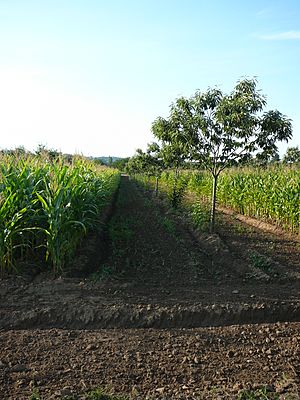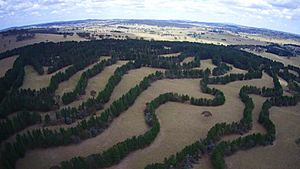Agroforestry facts for kids

Agroforestry (or agro-sylviculture) is a land use management system in which combinations of trees or shrubs are grown around or among crops or pastureland. Agroforestry combines agricultural and forestry technologies to create more diverse, productive, profitable, healthy, and sustainable land-use systems. There are many benefits to agroforestry such as increasing farm profitability. In addition, agroforestry helps to preserve and protect natural resources such as controlling soil erosions, creating habitat for the wildlife, and managing animal waste. Benefits also include increased biodiversity, improved soil structure and health, reduced erosion, and carbon sequestration.
Trees in agroforestry systems can also produce wood, fruits, nuts, and other useful products with economic and practical value. Agroforestry practices are especially prevalent in the tropics, especially in subsistence smallholdings areas with particular importance in sub-Saharan Africa. Due to its multiple benefits, for instance in nutrient cycle benefits and potential for mitigating droughts, it has been adopted in the USA and Europe .
Agroforestry shares principles with intercropping but can also involve much more complex multi-strata agroforests containing hundreds of species. Agroforestry can also utilise nitrogen-fixing plants such as legumes to restore soil nitrogen fertility. The nitrogen-fixing plants can be planted either sequentially or simultaneously.
Scientific basis
According to Paul Wojtkowski, the theoretical base for agroforestry lies in ecology, or agroecology. Agroecology encompasses diverse applications such as: improved nutrient and carbon cycling; water retention of soils; biodiverse habitats; protection from pest, disease and weed outbreaks; protection of soils from water and wind erosion, etc. From this perspective, agroforestry is one of the three principal agricultural land-use sciences. The other two are agriculture and forestry.
There is still not enough data to determine the full range of the impacts and benefits varying agroforestry practices could have. The indigenous practices that form the inspiration and basis for agroforestry are frequently complex, including a large array of species. The most studied agroforestry practices involve a simple interaction between two components, such as simple configurations of hedges or trees integrated with a single crop. There is significant variation in agroforestry systems and the benefits they have. Agroforestry as understood by modern science is derived from traditional indigenous and local practices, developed by living in close association with ecosystems for many generations. Although these agroforestry practices have sometimes been excluded from consideration as part of the "scientific" theory and practice of agroforestry, they form the foundation for modern agroforestry, and have enduring potential for future study and application.
Benefits
Agroforestry systems can be advantageous over conventional agricultural and forest production methods. They can offer increased productivity; social, economic and environmental benefits, as well as greater diversity in the ecological goods and services provided. It is essential to note that these benefits are conditional on good farm management. This includes choosing the right trees, as well as pruning them regularly etc.
Biodiversity
Biodiversity in agroforestry systems is typically higher than in conventional agricultural systems. Two or more interacting plant species in a given area create a more complex habitat that can support a wider variety of fauna.
Agroforestry is important for biodiversity for different reasons. It provides a more diverse habitat than a conventional agricultural system in which the tree component creates ecological niches for a wide range of organisms both above and below ground. The life cycles and food chains associated with this diversification initiates an agroecological succession that creates functional agroecosystems that confer sustainability. Tropical bat and bird diversity for instance can be comparable to the diversity in natural forests. Although agroforestry systems do not provide as many floristic species as forests and do not show the same canopy height, they do provide food and nesting possibilities. A further contribution to biodiversity is that the germplasm of sensitive species can be preserved. As agroforests have no natural clear areas, habitats are more uniform. Furthermore, agroforests can serve as corridors between habitats. Agroforestry can help to conserve biodiversity having a positive influence on other ecosystem services.
Soil and plant growth
Depleted soil can be protected from soil erosion by groundcover plants such as naturally growing grasses in agroforestry systems. These help to stabilise the soil as they increase cover compared to short-cycle cropping systems. Soil cover is a crucial factor in preventing erosion. Cleaner water through reduced nutrient and soil surface runoff can be a further advantage of agroforestry. Trees can help reduce water runoff by decreasing water flow and evaporation and thereby allowing for increased soil infiltration. Compared to row-cropped fields nutrient uptake can be higher and reduce nutrient loss into streams.
Further advantages concerning plant growth:
- Bioremediation
- Drought tolerance
- Increased crop stability
Role in sustainable agriculture
Agroforestry systems can provide a number of ecosystem services which can contribute to sustainable agriculture in the following ways;
- Diversification of agricultural products, such as fuelwood, medicinal plants, and multiple crops, increases income security
- Increased food security and nutrition by restored soil fertility, crop diversity and resilience to weather shocks for food crops
- Land restoration through reducing soil erosion and regulating water availability
- Multifunctional site use, e.g., crop production and animal grazing
- Reduced deforestation and pressure on woodlands by providing farm-grown fuelwood
- Possibility of reduced chemicals inputs, e.g. due to improved use of fertilizer, increased resilience against pests, and increased ground cover which reduces weeds
- Growing space for medicinal plants e.g., in situations where people have limited access to mainstream medicines
According to FAO's The State of the World’s Forests 2020, adopting agroforestry and sustainable production practices, restoring the productivity of degraded agricultural lands, embracing healthier diets and reducing food loss and waste are all actions that urgently need to be scaled up. Agribusinesses must meet their commitments to deforestation-free commodity chains and companies that have not made zero-deforestation commitments should do so.
Other environmental goals
Carbon sequestration is an important ecosystem service. Agroforestry practices can increase carbon stocks in soil and woody biomass. Trees in agroforestry systems, like in new forests, can recapture some of the carbon that was lost by cutting existing forests. They also provide additional food and products. The rotation age and the use of the resulting products are important factors controlling the amount of carbon sequestered. Agroforests can reduce pressure on primary forests by providing forest products.
Agroforestry practices may realize a number of environmental goals, such as:
- Odour, dust, and noise reduction
- Green space and visual aesthetics
- Enhancement or maintenance of wildlife habitat
Adaptation to climate change
Agroforestry can significantly contribute to climate change mitigation along with adaptation benefits. A case study in Kenya found that the adoption of agroforestry drove carbon storage and increased livelihoods simultaneously among small-scale farmers. In this case, maintaining the diversity of tree species, especially land use and farm size are important factors.
Especially in recent years, poor smallholder farmers turned to agroforestry as a means to adapt to climate change. A study from the CGIAR research program on Climate Change, Agriculture and Food Security (CCAFS) found from a survey of over 700 households in East Africa that at least 50% of those households had begun planting trees in a change from earlier practices. The trees were planted with fruit, tea, coffee, oil, fodder and medicinal products in addition to their usual harvest. Agroforestry was one of the most widespread adaptation strategies, along with the use of improved crop varieties and intercropping.
Historical use
Though the formal scientific study of agroforestry is relatively new, beginning in the 20th century with ethnobotanical studies carried out by anthropologists, agroforestry has existed for centuries, practiced by local and/or indigenous communities that lived in close relationship with forest ecosystems. Native American forestry practices are an example of this. Indigenous peoples of California periodically burned oak and other habitats to maintain a 'pyrodiversity collecting model'. This method allowed for greater tree health and improved habitat in general.
Challenges
Although agroforestry systems can be advantageous, they are not widespread in the US as of 2013.
As suggested by a survey of extension programs in the United States, obstacles (ordered most critical to least critical) to agroforestry adoption include:
- Lack of developed markets
- Unfamiliarity with technologies
- Lack of awareness
- Competition between trees, crops and animals
- Lack of financial assistance
- Lack of apparent profit potential
- Lack of demonstration sites
- Expense of additional management
- Lack of training or expertise
- Lack of knowledge about where to market products
- Lack of technical assistance
- Adoption/start up costs, including costs of time
- Unfamiliarity with alternative marketing approaches (e.g. web)
- Unavailability of information about agroforestry
- Apparent inconvenience
- Lack of infrastructure (e.g. buildings, equipment)
- Lack of equipment
- Insufficient land
- Lack of seed/seedling sources
- Lack of scientific research
Some solutions to these obstacles have been suggested.
See also
- Afforestation
- Carbon farming
- Deforestation
- Deforestation and climate change
- Farmer-managed natural regeneration
- Fertilizer tree
- Forest farming
- Forest gardening
- LULUCF
- Mycoforestry
- Pastoral farming
- Permaculture
- Streuobstwiese
- Sustainable agriculture
- Sustainable forest management
- Silviculture
- Silvopasture



